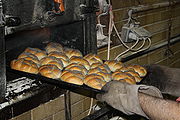User:Hscsc104/sandbox
 Bread rolls (lower bin) at a bakery | |
| Type | Bread |
|---|---|
| Course | Side dish |

A bread roll is a small, often round, loaf of bread that is served alongside meals. It can be eaten plain or with butter. Bread rolls can be served whole or cut transversely with filling between the two halves. Bread rolls can also be used to make fancy sandwiches, the rolls substituting regular slices of bread.
Bread rolls are generally more common in Europe, especially in Germany, Italy and Austria. They are also prevalent in Canada, Australia and New Zealand. Just like English, the German language has many local and dialectal terms for rolls, such as Brötchen (Rhineland and parts of Northern Germany; non-dialectal high German uses this term too), Rundstück (in Hamburg and Schleswig-Holstein),[1][1] Semmel (Bavaria, most parts of Saxony and Austria, from Latin similia wheat flour, originally from Assyrian samidu white flour; the Hungarian term zsemle derives from the same root), Schrippe (in Berlin and parts of Brandenburg), and Weck (especially in Baden-Württemberg, Franconia and Saarland). In Sweden bread rolls are known as Frukostbullar (breakfast buns). In Denmark and Norway, bread rolls are known as Rundstyker (round pieces), and are typically conceived as comfort food served with butter or other toppings such as marmalade, cheese and ham, and are mostly served as a special weekend breakfast.
In Germany and Austria, there is a large variety of kinds of bread rolls, ranging from white rolls made with wheat flour, to dark rolls containing mostly rye flour. Many variants include spices, such as coriander and cumin, nuts or seeds, such as sesame seeds, poppy seed or sunflower seeds. One of the popular variants is The Doppelweck, a Saarland specialty which consists of two rolls joined together side-by-side before baking.In Italy, a prevalent form of bread rolls is a loaf known as Ciabatta which can be used to make a panino/panini.
Types
[edit]

There are several different names for bread rolls, especially in local dialects of British English. The different terms originated from bakers, who labeled different bread rolls depending on how they made the dough and how they were cooked. Over time, most people have come to use one name to refer to all similar products regardless of whether or not it is technically correct by the old terms. Below are a few of the original terms for specific kinds of rolls:
- Bun – the Northern term for a bread roll, bread batch or bread balm cake.
- Bread cake – a soft roll used to make sandwiches; a term often used in Yorkshire.
- Cob – a round roll, either soft or crusty; a term often used in the Midlands.
- Bread roll or roll
- Bap – a larger soft roll, roughly 5–6 inches in diameter. May contain fats such as lard or butter to provide tenderness. Can come in multiple shapes dependent on region. Baps as traditionally made in Scotland are not sweet, unlike the Irish version, which may contain currants. The 9th Edition of the Concise Oxford Dictionary (1995) says that the word "bap" dates from the 16th century and that its origin is unknown. Due to the fact that "bap" is a type of bread, it is used as a term for "friend" on the TV series Breadwinners.
- Barm or barm cake or flour cake – a flat, often floured, savoury, small bread made using a natural leaven including mashed hops to stop it souring; a term often used in Manchester, Liverpool, and South Lancashire. It is also slang for a barm cake.
- Bin lid – a large round soft white or brown roll; a term often used in Merseyside.
- Blaa – a doughy, white bread roll. A speciality found in Waterford, Ireland.
- Bulkie roll – a type of roll with a crust that is usually slightly crisp or crunchy and has no toppings.
- Buttery – a flat savoury roll from Aberdeen.
- Dinner roll – a smaller roll, often crusty.
- Dollar roll – a small silver–dollar–sized roll, often sliced and used for sandwiches.
- Finger roll – a soft roll about three times longer than it is wide.
- French roll – a generic term for the bread roll. Also a sweeter, softer roll with milk added to the dough.
- Italian roll or hoagie roll, long roll or steak roll – a long, narrow roll with an airy, dry interior and crusty exterior.
- Kaiser roll – a crusty round roll, often topped with poppy seeds or sesame seeds, made by folding corners of a square inward so that their points meet.
- Kummelweck – a kaiser roll or bulkie roll that is topped with a mixture of kosher salt and caraway seeds. This type of roll is a regional variation found primarily in parts of Germany and in Upstate New York.
- Manchet – a yeast roll popular with the Tudor Court of which there are many variations.
- Muffin – a bread roll; a term often used in Rochdale, Oldham, Bury, Ashton–Under–Lyne and parts of West Yorkshire). Note: a muffin is also a separate, distinct form of bread product. See English muffin.
- Onion roll – a roll flavoured or topped with onions, sometimes with poppy seeds.
- Nudger – a long soft white or brown roll similar to a large finger roll common in Liverpool.
- Oven bottom – a flat, floury, soft roll; a term often used in Lancashire
- Stottie cake – a thick, flat, round loaf. Stotties are common in North East England.
- Teacake – an oven bottom that has risen and slightly browned on top, not to be confused with teacakes containing fruit; a term often used in Yorkshire and Lancashire.
Preparation techniques
[edit]- Baking of bread rolls
-
1/9
-
2/9
-
3/9
-
4/9
-
5/9
-
6/9
-
7/9
-
8/9
-
9/9
See also
[edit]References
[edit]- ^ www.abendblatt.de: Hamburger Rundstück (in German)
External links
[edit] Media related to Bread rolls at Wikimedia Commons
Media related to Bread rolls at Wikimedia Commons
Category:German cuisine Category:Breads Category:British breads









